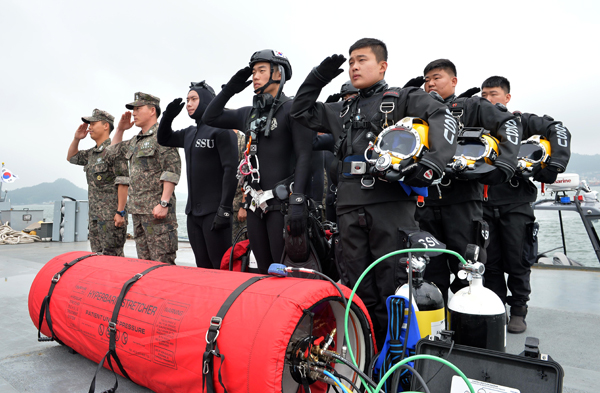Navy dispatches new rescue teams to three fleets

A rescue operations team, equipped with diving gear, is dispatched to the 3rd Fleet in charge of overseeing Korea’s southwestern seas on Wednesday. The Navy launched new rescue operations teams to three naval fleets to help expedite the search and rescue process in the event of a disaster. Provided by the Korean Navy
In an attempt to boost emergency response to take advantage of the first few critical moments after a disaster, the Navy launched the new teams in its 1st, 2nd and 3rd Fleets, covering the country’s western, southern and eastern seas.
Each rescue operations team will contain 15 to 17 trained deep-sea divers from the Navy’s Ship Salvage Unit (SSU).
A lieutenant-rank naval officer will command each team and prioritize an early and speedy response in the event of a maritime accident or disaster.
“In an event in which an accident happened at sea, like with the Sewol sinking last year, the SSU faced limitations in terms of how fast it could respond because it’s based in Jinhae,” a Navy official said. “In order to take advantage [of the first few crucial minutes of a disaster], being able to quickly get to the scene is essential [to rescue the victims], so we’ve decided to dispatch SSU members to each fleet.”
The teams will be equipped with surface-supplied diving systems (SSDS), used for operations requiring deep sea diving more than 30 meters (98.42 feet) under water, as well as scuba diving equipment, side-scan sonars to create images in the sea and portable decompression chambers. This would enable rescuers to dive as deep as 58 meters for a longer period.
The Navy said it will also work on expediting communication, so that fleets can report to a higher level of command and disseminate details of a situation more quickly, and deploy a guided-missile patrol gun boat to transport rescuers to the scene of the accident.
It also plans to equip all combat vessels and helicopters with inflatable lifeboats by next year.
BY SARAH KIM, JEONG YONG-SOO [kim.sarah@joongang.co.kr]










with the Korea JoongAng Daily
To write comments, please log in to one of the accounts.
Standards Board Policy (0/250자)